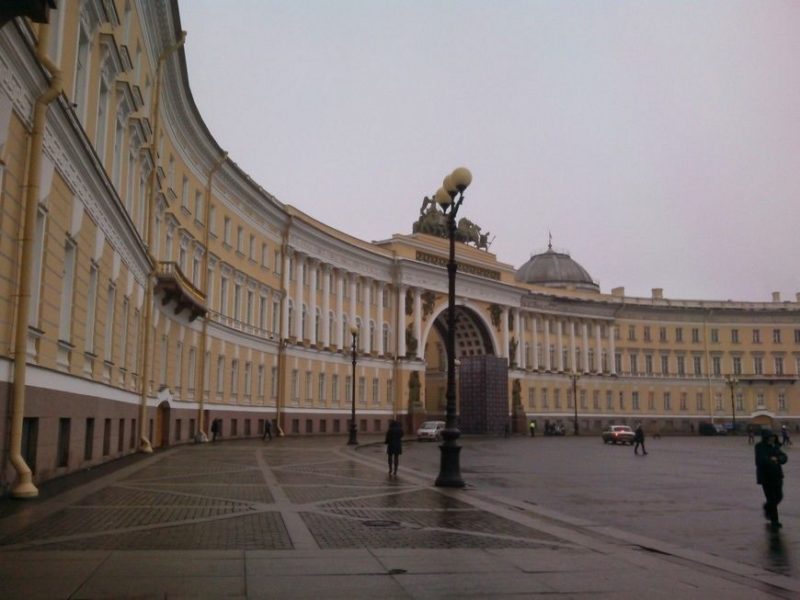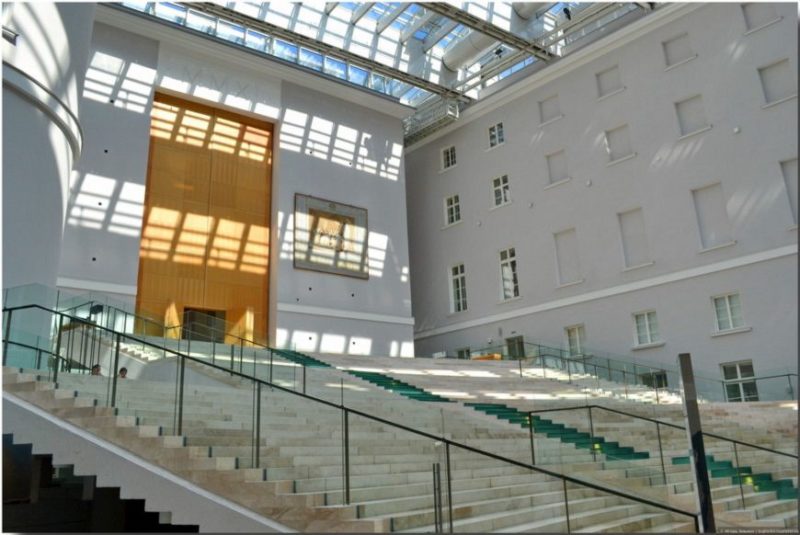The General Staff of the Hermitage in St. Petersburg
The General Staff Building, located on Palace Square, is one of the most monumental buildings of St. Petersburg. Together with the Winter Palace and the Alexander Column, it forms the majestic ensemble of the main square of the Northern capital.
Initially, the present Palace Square was built up with scattered houses, among whose owners were many famous people of the city. The idea to place opposite the imperial residence - the Winter Palace - the main headquarters of the Russian army belonged to Alexander I. To translate his idea, the emperor orders to redeem their property from the owners and conduct a large-scale reconstruction of the square.
Construction continues for a decade - from 1819 to 1829. The author of the project, eminent architect Karl Rossi, manages to create a building of amazing beauty and scale, which becomes one of the symbols of St. Petersburg.
The headquarters consists of two parts - the western (closer to Nevsky Prospect) and the eastern wing (closer to the Moyka). They are united in a single whole triumphal arch with the chariot of the goddess Nike. Despite the name that came into use, the General Staff occupied only a part of the new building - the western wing. The eastern part housed the Ministry of Foreign Affairs and the Ministry of Finance.
At present, the command of the Western Military District is located in the western wing of the General Staff building. And the eastern was transferred to the State Hermitage Museum, which placed in it an exhibition of art of the XIX-XXI century. In the building of the General Staff of the Hermitage you can admire the canvases of famous impressionists and post-impressionists. Also here are regularly held exhibitions of contemporary art.
Museum in the General Staff Building
The eastern wing of the General Staff became part of the Hermitage in 1988. In 2008, a large-scale reconstruction of the complex began in order to adapt it for museum needs. The renovated building was opened in 2014, the year of the 250th anniversary of the Hermitage.
The new building of the Hermitage carefully combines historical details and modern solutions. During the renovation all the remaining interiors were restored. Repaired 26 furnaces. Fully restored apartment of Count Nesselrode. For the first time in Russia, light traps were installed on the fourth floor, which ensure the entry of light into the exhibition halls in a safe form for the exhibiting works of art. The vast spaces of the former public institutions are united by courtyards with glass ceilings - atriums. Bridges of glass are laid between the exhibition halls.
The museum space in the new building was organized in the same way as in the other buildings of the Hermitage - the exhibition halls are arranged according to the principle of an enfilade. The premises are combined in three enfilade lines.
Exhibitions in the General Staff of the Hermitage
The museum has both permanent exhibitions and temporary exhibitions. Its halls are the main platform for displaying contemporary art.
Permanent exhibitions
The General Staff Museum is located on 4 floors. On the 1st floor there are service rooms and a lecture hall. The exhibition halls occupy the three remaining floors.
On the 2nd floor there is an exhibition "Art of the modern era". Another thematic exhibition tells about the work of the former "owner" of this part of the building - the Ministry of Finance. Also on the 2nd floor you can get acquainted with the art of the peoples of Africa. The atrium exhibits sculptures of the 20th century.
On the 3rd floor are located halls with European painting of the XIX century (Germany, France, Holland, Belgium). The Museum of the Guard presents exhibits introducing the history of the Russian Guards - weapons, uniforms and other military relics. Here you can see the true uniform of Peter I. In the halls dedicated to the memory of Carl Faberge, exhibits are exhibited related to jewelry and stone carving.
Part of the premises of the third floor is allocated to the exhibition dedicated to the Ministry of Foreign Affairs, which was once located here. In addition to the exhibits, you should take a look at the restored ceremonial halls and visit the apartment of the Minister of Foreign Affairs, Count Nesselrode, decorated by Empire State Carl Rossi. The apartment was fully restored during the restoration works of 2008-2014.
Here, on the 3rd floor, there are halls of modern art - Ilya Kabakov and Dmitry Prigov.
Impressionists
The collection of world-famous impressionists and post-impressionists is the main magnet of the new building of the Hermitage. Their canvases are exhibited on 4 floors in the “Gallery of the memory of Sergei Schukin and the Morozov brothers”.
Visitors can enjoy the works of Claude Monet, Edgar Degas, Paul Cezanne, Vincent van Gogh, Paul Gauguin and other recognized masters. A separate room is occupied by the works of Auguste Rodin. Part of the exhibition is reserved for paintings by artists of the early XX century - among them Pablo Picasso, Henri Matisse, Wassily Kandinsky.
Architect and architecture
The General Staff building was built in the Empire style. The architect of the project is K. Rossi, the sculptors are S. S. Pimenov and V. I. Demut-Malinovsky. Rossi does not just repeat the line of buildings that had previously stood on the square, but also leaves part of the facades and individual elements of the interior decorations.
The building consists of two buildings, united by an arch. The length of the curved arc of the central facade is 580 m. The western and eastern buildings are not identical in length, but the architect visually balances them, decorating the western part with a portico with 14 columns, and the eastern part with a portico with 12 columns.
The facade of the central part of the General Staff building has a flat relief. Even the entrance groups are almost not noticeable on the general background. However, the building does not seem monotonous due to its parabolic shape.
Rossi masterfully enters the new building in a single ensemble of Palace Square. The General Staff building harmoniously echoes the Winter Palace, despite the fact that they are built in opposite styles - the magnificent Boroko in the Winter Palace and the strict classics in the General Staff.
Arch of the General Staff
The central and most recognizable element of the General Staff building is the triumphal arch. It consists of three arches connected to each other. The first arch frames the entrance to the Palace Square. Immediately behind it is the second parallel. The third arch, located at an angle to the first two, was used by the architect Rossi in order to change the direction of Bolshaya Morskaya Street and bring it to the square in front of the Winter Palace. After the construction of the arch of the General Staff building became the main entrance to the Palace Square.
The Triumphal Arch is designed so that its center is located on the same line with the center of entry to the courtyard of the Winter Palace. The Alexander Column was later installed on this invisible line. Through the arch offers a magnificent view of the Palace Square.
The Triumphal Arch is a monument to the prowess of the Russian soldiers in the war of 1812. Traditional antique motifs are used in its design. The arch is crowned with a flying chariot of the goddess of glory, Nika. Warriors in armor hold six horses torn forward. The motif of victory is repeated in other decorative elements. Walls and vaults adorn the figures of the goddess of glory, war wreaths and trophies, laurel wreaths and palm branches.
The Arch of the General Staff impresses with its size. Its height is 28 m. The width of the span is 17 m. The height of the goddess Nika is 10 m, and the horses are 3 m.
It may also be interesting
- How to travel in Saint Petersburg without living your home
- Four of the ten best restaurants in the country are in St. Petersburg
- The first Holocaust museum in St. Petersburg
- A scientist from St. Petersburg created the biochronicle of Peter the Great.
- 10 interesting facts about Saint-Petersburg streets





